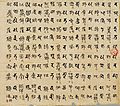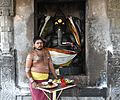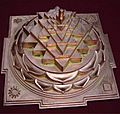Tantra facts for kids
Tantra is a name for a group of spiritual traditions that come from India. These traditions are often seen as secret or special knowledge. Tantra can be found in different religions. These include Hinduism, Buddhism, Bonpo, and Jainism.
Tantra has been practiced in many parts of Asia. This includes South Asia, China, Japan, Tibet, Korea, Cambodia, Myanmar, Indonesia, and Mongolia. The word "Tantra" comes from two words. "Tanoti" means to free up energy. "Trayati" means to make your awareness bigger.
Contents
What is Tantra?
Tantra is a way of life and a set of practices. It helps people connect with their inner power. It also helps them understand the world around them. Tantra uses special rituals, meditations, and yoga. It aims to help people reach a higher state of mind.
Key Ideas in Tantra
Tantra teaches that everything in the universe is connected. It sees the world as a dance between two main energies. These are often called Shiva and Shakti.
- Shiva represents pure awareness or consciousness.
- Shakti represents energy, power, and creation.
Tantra aims to bring these two energies together within a person. This helps them feel more complete and powerful.
Practices in Tantra
People who follow Tantra use different methods. These practices help them grow spiritually.
- Yoga and Meditation: Many Tantric traditions use specific yoga poses and breathing exercises. They also use deep meditation to calm the mind.
- Mantras: These are special sounds or words repeated during meditation. They help focus the mind and create positive energy.
- Mandalas and Yantras: These are sacred geometric designs. They are used as tools for meditation and focus. They help people connect with spiritual ideas.
- Rituals: Tantra often includes special ceremonies and offerings. These rituals help people show their devotion and connect with divine energies.
Tantra in Different Religions
Tantra is not a single religion itself. Instead, it is a set of practices found within many religions.
Hindu Tantra
In Hinduism, Tantra is very important. It is often linked to the worship of goddesses. These goddesses are seen as forms of Shakti. Hindu Tantra focuses on awakening inner energy. This energy is sometimes called Kundalini. It is believed to rest at the base of the spine.
Buddhist Tantra
In Buddhism, Tantra is also known as Vajrayana. This means "Diamond Vehicle." It is common in Tibet and other Himalayan regions. Buddhist Tantra uses special visualizations and meditations. It helps people quickly reach enlightenment. It teaches that all beings have the potential to become a Buddha.
History of Tantra
Tantric traditions have a long history. They began in India many centuries ago. Over time, they spread to other parts of Asia.
- Early Tantric texts appeared around the 6th century CE.
- These traditions grew and changed over hundreds of years.
- They influenced art, architecture, and philosophy in many cultures.
Tantra has always been about personal experience. It encourages people to explore their own minds and bodies. It helps them find spiritual truth from within.
Images for kids
-
An image of a yogi and their chakras.
-
The Brihadisvara Temple, a temple in Tamil Nadu.
-
A Kali Puja (a special ritual).
-
A Pujari in front of a Ganesha statue at the Brihadishwara Shiva Temple.
-
Shri Yantra diagram with the Ten Mahavidyas. The triangles show Shiva and Shakti.
-
The Shri Yantra (shown here as Sri Meru), used by some Tantric groups.
See also
 In Spanish: Tantra para niños
In Spanish: Tantra para niños















